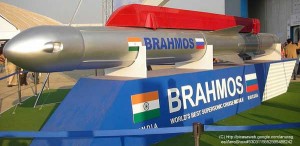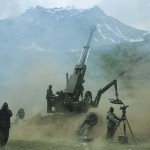In a replay of cold war rivalries, a new missile race is shaping up but this time America and Russia are joined by India and China. All of these nations are rushing to develop new anti-ship missiles that threaten to revolutionise naval warfare and alter global balances of power.
It’s all about who can design the fastest missiles with the latest engine technology.
American Tomahawk cruise missiles are powered by conventional turbofans, which are essentially compact versions of passenger jet engines. These propel the missiles at 880 km/h – seventy percent the speed of sound, or Mach 0.7.
Much faster velocities can be reached with a ramjet, which has no moving mechanical parts. Air is rammed into the engine at supersonic speeds to heat it up and ensure it burns more powerfully with the fuel. In order to avoid blowing out the combustion flames, the airflow is slowed within the engine to below the speed of sound. Since the ramming effect only works at high speeds, these jets must first be accelerated by another system.
 The BRAHMOS missile, co-developed by India and Russia, illustrates the deadly capabilities of ramjet weapons. The BRAHMOS is launched with a rocket, which falls away when the missile gets up to speed. Then the ramjet-powered stage with the warhead kicks in, cruising at Mach 2.8 (3,400 km/h) for 290 km. It can fly at an altitude of 15 km or sneak up on targets by hugging the ground. Land- and ship-based versions of this weapon are already in service in India, and next year it will be fitted to Indian fighter jets.Supersonic missiles fly so fast that ships have little time to deploy countermeasures. This increases the chance of a missile slipping past a vessel’s screen of defenses – but these high-speed weapons can be stopped. However, there is currently no reliable defense against the much faster next generation of anti-ship missiles, which will fly at hypersonic speeds – greater than Mach 5 (6,100 km/h).
The BRAHMOS missile, co-developed by India and Russia, illustrates the deadly capabilities of ramjet weapons. The BRAHMOS is launched with a rocket, which falls away when the missile gets up to speed. Then the ramjet-powered stage with the warhead kicks in, cruising at Mach 2.8 (3,400 km/h) for 290 km. It can fly at an altitude of 15 km or sneak up on targets by hugging the ground. Land- and ship-based versions of this weapon are already in service in India, and next year it will be fitted to Indian fighter jets.Supersonic missiles fly so fast that ships have little time to deploy countermeasures. This increases the chance of a missile slipping past a vessel’s screen of defenses – but these high-speed weapons can be stopped. However, there is currently no reliable defense against the much faster next generation of anti-ship missiles, which will fly at hypersonic speeds – greater than Mach 5 (6,100 km/h).
China is developing its own hypersonic anti-ship missile, the Dong Feng 21D. This isnt a cruise missile but rather a ballistic missile that is launched toward space before arcing back to Earth.
Hypersonic velocities can be attained with scramjets, which are similar to ramjets but with combustion occurring at much faster supersonic velocities. There is no need to slow the air before it reaches the combustion flames. The US Air Force compares running a scramjet to “lighting a match in a hurricane and keeping it burning.” However, like ramjets, scramjets must first be boosted to running speed with rockets.
India and Russia are working on the hypersonic BRAHMOS II, which is expected to be in service by 2013. Cruising at about Mach 6 (7,300 km/h), this scramjet-powered missile will carry thirty-six times more kinetic energy than a similar weapon at Mach 1. It will therefore pack a much larger punch if used to slam through hardened bunkers or underground nuclear or biological weapons facilities. It can also be used against ships.
China is developing its own hypersonic anti-ship missile, the Dong Feng 21D. This isn’t a cruise missile but rather a ballistic missile that is launched toward space before arcing back to Earth at about Mach 10. The DF-22 will cover a range of about 1,500 km. The technology behind the DF-21D is nothing new – the weapon is a variant of a proven Chinese medium range ballistic missile. What is new – and a potential game-changer – is the possibility of precisely striking ships at long range with non-nuclear warheads.
Dubbed the “carrier killer,” it is believed this new weapon could be used against American aircraft carriers to destroy US naval supremacy in the western Pacific and block America from coming to the defense of Taiwan. The possibility of a Chinese knock-out blow against the US Navy raises the specter of a Pearl Harbor of the twenty-first century – but in the open waters of the South China Sea.
The BRAHMOS missile, co-developed by India and Russia, illustrates the deadly capabilities of ramjet weapons.
“China’s ability to bypass America’s robust air-defense capability and strike ships at sea with ballistic missiles could severely limit American naval power,” note Abraham Denmark and James Mulverson of the Center for a New American Security.
However, the Chief of India’s Navy is dismissive of China’s hypersonic anti-ship missile program. As reported by the Indian Express, Admiral Nirmal Verma believes “Targeting ships on the high seas is not an easy task … There are limitations in terms of maritime reconnaissance and long-range searches.” He adds that it is a “complex problem” to use a conventional missile against a moving target on the high seas.
However, with enough time and resources China could overcome these technical challenges and threaten America’s crucial carriers.
Defending against hypersonic weapons is complicated by the fact that their speeds make them difficult to track and target. Automated decisions must be made instantaneously, and fast moving missiles can easily sidestep whatever is thrown at them through last second violent maneuvers or slight velocity changes.
The most practical defense is to strike the incoming weapon with another hypersonic missile, the proverbial “hitting a bullet with another bullet.” The United States has proven it can do this, albeit in controlled tests and with inconsistent results. Further ballistic missile defense research could be applied to dealing with threats posed by the DF-21D. However, a reliable missile defense shield is a long way off.
America is also working on hypersonics with its X-51A Waverider, which is designed to demonstrate scramjet technology for missiles and spaceplanes. According to the US Air Force, a 200-second test last May marked the first flight of a practical hydrocarbon-fueled scramjet (the engine runs on a special jet fuel).
With this confirmed success, America appears to have taken the lead in the hypersonic missile race. However, the competition isn’t far behind and the stakes are high. This was clearly explained by US Secretary of Defense, Robert Gates, in his address to an Air Force Association Convention in 2009.
“When considering the military-modernization programs of countries like China,” said Gates, “we should be concerned less with their potential ability to challenge the US symmetrically – fighter to fighter or ship to ship – and more with their ability to disrupt our freedom of movement and narrow our strategic options. Their investments in … anti-ship weaponry and ballistic missiles could threaten America’s primary way to project power and help allies in the Pacific – in particular our forward air bases and carrier strike groups.”
The proliferation of advanced cruise missiles to so-called “rogue states” adds to this instability. Iran, for example, could use these weapons to keep foreign naval vessels out of the Persian Gulf and allow it to control oil shipments through the narrow Strait of Hormuz. Twenty percent of the world’s oil trade is shipped through this chokepoint.
Iran has previously caused mischief with subsonic missile technology from China, launching attacks on neighbors and oil tankers. Were it to get hold of faster supersonic anti-ship missiles, it could pose a more serious threat to oil shipping.
The race is on to develop the next generation of anti-ship missiles that could reshape naval warfare – and dictate who will rule the waves.




